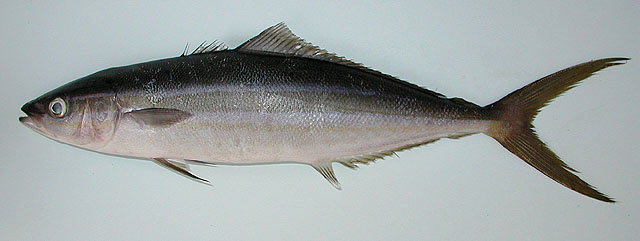| Carangidae (Jacks and pompanos), subfamily: Naucratinae |
| 180 cm TL (male/unsexed); max.weight: 46 kg; max. reported age: 6 years |
|
reef-associated; marine; depth range 0 - 150 m |
| Western Atlantic: Massachusetts, USA and northern Gulf of Mexico to Rio de Janeiro, Brazil (Ref. 57756). Eastern Atlantic: off Genoa, Italy in the Mediterranean (Ref. 4233) and from Côte d'Ivoire to Angola (Ref. 7097). Throughout the Indo-Pacific (Ref. 37816), but rare or absent in the Persian Gulf (Ref. 3287). Eastern Pacific: mouth of Gulf of California to Ecuador; including the Galapagos Islands (Ref. 9283). |
|
Dorsal spines (total): 7-7; Dorsal soft rays (total): 25-30; Anal spines: 2-2; Anal soft rays: 18-22; Vertebrae: 24-24. This species is distinguished by the following characters: the upper jaw ending distinctly before eye (and to below anterior margin of eye in young); dorsal fin with a detached terminal 2-rayed finlet; anal fin with a slightly detached spine from the rest of fin and covered by skin in fish of larger sizes, then followed by a second spine continuous with the 18-22 soft rays, including a detached 2-rayed finlet. Colour dark olive-blue or green dorsally and on side, white ventrally with 2 narrow light blue or bluish white stripes along sides and a broader olive or yellowish stripe between them; fins olive or yellowish (Ref. 9894,90102).
Description: Anal fin base is shorter than that of dorsal fin base. Dorsal and anal fins are relatively short; with small two-rayed pinnulae just behind the dorsal and anal fins (Ref. 4795). |
| Adults are found in oceanic and coastal waters, generally near the surface over reefs or sometimes far from the coast often around floating logs or other debris (Ref. 9283, 11230, 48635, 90102). May form large schools (Ref. 9283, 48635). They feed on invertebrates, mainly on larger crustaceans of the zooplankton, and small fishes (Ref. 9283, 26145). Eggs are pelagic (Ref. 4233). Good food fish (Ref. 9626) and a valued game fish (Ref. 26938); marketed fresh and salted or dried (Ref. 9283); also frozen and used for sashimi (Ref. 9987). |
|
Least Concern (LC); Date assessed: 21 August 2012 Ref. (130435)
|
| reports of ciguatera poisoning |
Source and more info: www.fishbase.org. For personal, classroom, and other internal use only. Not for publication.
